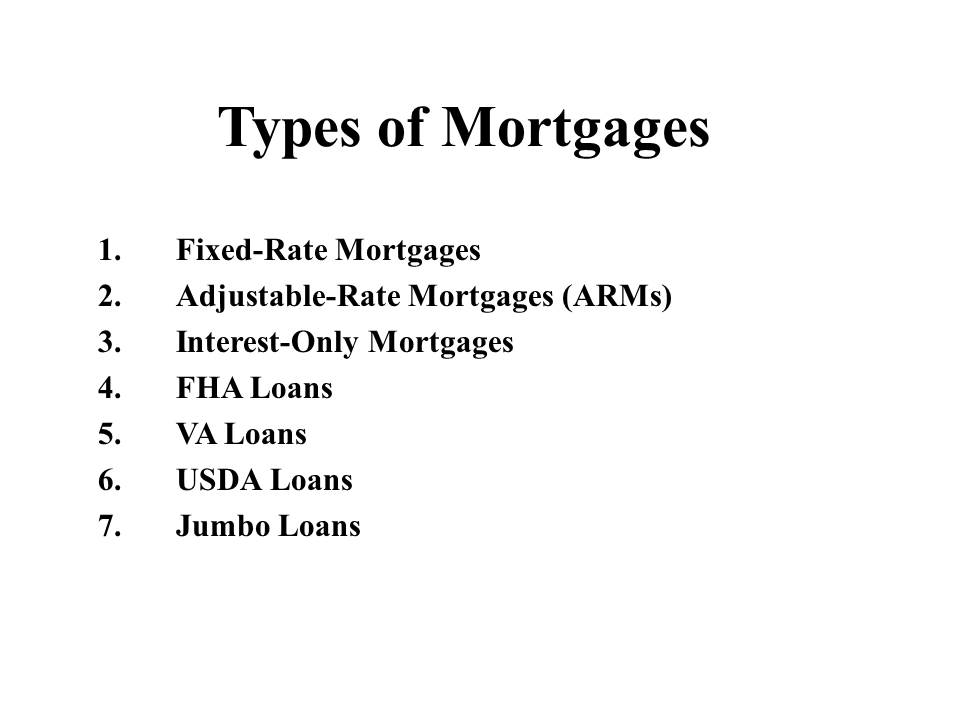Demystifying Mortgages: Your Comprehensive Guide to Home Financing
The dream of homeownership is a cornerstone of the American dream. Owning a home represents stability, security, and a place to call your own. However, for most people, buying a home is one of the biggest financial decisions they will ever make. Unless you have a considerable amount of cash on hand, you will likely need a mortgage to purchase your home.
In this comprehensive guide, we will explore the world of mortgages, breaking down the complex jargon, and helping you understand the various aspects involved. From the types of mortgages available to the steps in the mortgage process, and even tips for managing your mortgage effectively, this guide has you covered.
Table of Contents
- Introduction to Mortgages
- What Is a Mortgage?
- The Importance of Homeownership
- Why Do You Need a Mortgage?
- Types of Mortgages
- Fixed-Rate Mortgages
- Adjustable-Rate Mortgages (ARMs)
- Interest-Only Mortgages
- FHA Loans
- VA Loans
- USDA Loans
- Jumbo Loans
- The Mortgage Application Process
- Preparing Your Finances
- Choosing the Right Lender
- The Application Timeline
- The Role of Credit Scores
- The Down Payment
- The Mortgage Approval Process
- Income Verification
- Employment History
- Debt-to-Income Ratio
- Appraisal and Home Inspection
- Understanding Mortgage Interest Rates
- How Interest Rates Are Determined
- Fixed vs. Adjustable Interest Rates
- Locking in Your Interest Rate
- Mortgage Closing
- Closing Costs
- The Closing Disclosure
- The Role of Title Insurance
- Signing the Mortgage Documents
- Managing Your Mortgage
- Making Your Monthly Payments
- Escrow Accounts
- Refinancing Your Mortgage
- Dealing with Financial Hardships
- Mortgage Tips and Strategies
- The Importance of a Budget
- Paying Off Your Mortgage Early
- Mortgage Mistakes to Avoid
- Planning for the Future
- Conclusion
- Achieving Your Dream of Homeownership
- The Ongoing Journey of Mortgage Management
Chapter 1: Introduction to Mortgages
What Is a Mortgage?
A mortgage is a financial agreement between a borrower and a lender that allows the borrower to purchase a home by borrowing money. The home itself serves as collateral for the loan. In other words, if the borrower fails to make their mortgage payments, the lender has the right to take possession of the home through a legal process known as foreclosure.
The Importance of Homeownership
Homeownership offers numerous benefits, including building equity, providing stability, and offering potential tax advantages. When you own a home, you have the freedom to make it your own, personalize it to your liking, and enjoy the long-term benefits of property appreciation.
Why Do You Need a Mortgage?
Homes are typically expensive, and few people can afford to pay for them in cash. This is where mortgages come into play. By spreading the cost of a home over many years, mortgages make homeownership accessible to a broader range of people.
In the following chapters, we will delve deeper into the types of mortgages available, the application process, and strategies for managing your mortgage effectively.

Chapter 2: Types of Mortgages
Fixed-Rate Mortgages
Fixed-rate mortgages offer stability by locking in an interest rate for the entire duration of the loan. This means your monthly payments remain the same throughout the life of the mortgage.
Adjustable-Rate Mortgages (ARMs)
ARMs start with a fixed interest rate for an initial period and then adjust periodically based on market conditions. These mortgages often have lower initial rates but come with the risk of rising payments in the future.
Interest-Only Mortgages
Interest-only mortgages allow borrowers to pay only the interest for a specified period, typically the first few years. Afterward, borrowers must start paying both principal and interest. These mortgages can be risky if property values don’t appreciate as expected.
FHA Loans
FHA loans are government-insured mortgages designed for low-to-moderate-income borrowers. They require a lower down payment and have more flexible qualification requirements.
VA Loans
VA loans are available to eligible veterans and active-duty service members. They often require no down payment and have favorable terms, making homeownership more accessible to those who have served our country.
USDA Loans
USDA loans are backed by the U.S. Department of Agriculture and are designed to help low-income borrowers in rural areas purchase homes. They often require no down payment and offer competitive interest rates.
Jumbo Loans
Jumbo loans are for homes that exceed the conforming loan limits set by government-sponsored enterprises like Fannie Mae and Freddie Mac. These loans typically have stricter credit requirements and higher interest rates.
Understanding the different types of mortgages is crucial for choosing the one that best suits your financial situation and homeownership goals.
Chapter 3: The Mortgage Application Process

Preparing Your Finances
Before applying for a mortgage, it’s essential to assess your financial situation. This involves reviewing your credit report, reducing existing debt, and saving for a down payment and closing costs.
Choosing the Right Lender
Selecting the right lender is a critical decision. Research different lenders, compare their rates and terms, and consider factors like customer service and responsiveness.
The Application Timeline
The mortgage application process involves several stages, from pre-approval to closing. Understanding this timeline can help you manage your expectations and plan accordingly.
The Role of Credit Scores
Your credit score plays a significant role in mortgage approval and the interest rate you receive. Learn how to improve your credit score before applying for a mortgage.
The Down Payment
The down payment is a lump sum you pay upfront when purchasing a home. Learn about different down payment options and how they affect your mortgage.
Chapter 4: The Mortgage Approval Process
Income Verification
Lenders will assess your income to determine your ability to repay the loan. Be prepared to provide documentation such as pay stubs, tax returns, and bank statements.
Employment History
A stable employment history can positively impact your mortgage approval. Lenders prefer borrowers with a consistent work record.
Debt-to-Income Ratio
Your debt-to-income ratio compares your monthly debt payments to your income. A lower ratio increases your chances of mortgage approval.
Appraisal and Home Inspection
Lenders require an appraisal to assess the home’s value and ensure it’s worth the loan amount. Additionally, a home inspection is crucial to identify any potential issues.
Chapter 5: Understanding Mortgage Interest Rates
How Interest Rates Are Determined
Interest rates are influenced by various factors, including the federal funds rate, inflation, and the economy. Understanding these factors can help you predict interest rate trends.
Fixed vs. Adjustable Interest Rates
Choosing between fixed and adjustable interest rates depends on your financial goals and risk tolerance. Learn the pros and cons of each.
Locking in Your Interest Rate
Interest rate locks allow you to secure a specific rate for a set period. This can protect you from rate increases while your mortgage application is processed.
Chapter 6: Mortgage Closing
Closing Costs
Closing costs are fees associated with finalizing the mortgage transaction. They include lender fees, appraisal fees, title insurance, and more. Understanding these costs can help you budget effectively.
The Closing Disclosure
The Closing Disclosure is a document provided by your lender that outlines the final loan terms and closing costs. Review it carefully before closing.
The Role of Title Insurance
Title insurance protects your ownership rights to the property. It’s essential to understand how title insurance works and why it’s necessary.
Signing the Mortgage Documents
Closing day involves signing a stack of mortgage documents. Learn about the key documents you’ll encounter and what each one means.
Chapter 7: Managing Your Mortgage
Making Your Monthly Payments
Managing your mortgage involves making timely monthly payments. Learn about different payment options and strategies for staying on top of your mortgage.
Escrow Accounts
Many lenders require borrowers to have escrow accounts for property taxes and homeowners insurance. Understand how escrow works and its impact on your monthly payments.
Refinancing Your Mortgage
Refinancing can lower your interest rate, reduce your monthly payments, or even change your loan term. Learn when it makes sense to refinance your mortgage.
Dealing with Financial Hardships
Life can bring unexpected financial challenges. Discover options for managing your mortgage during tough times, such as loan modification and forbearance.
Chapter 8: Mortgage Tips and Strategies
The Importance of a Budget
Creating a budget is crucial for managing your mortgage effectively. Learn how to budget for your monthly mortgage payment and other homeownership expenses.
Paying Off Your Mortgage Early
Paying off your mortgage ahead of schedule can save you money on interest. Explore strategies for accelerating your mortgage payoff.
Mortgage Mistakes to Avoid
Avoid common pitfalls, such as taking on too much debt or not shopping around for the best mortgage deal. Learn from the mistakes of others to make informed decisions.
Planning for the Future
Your mortgage is a long-term commitment. Consider how it fits into your overall financial plan, including retirement and other financial goals.
Chapter 9: Conclusion
Achieving Your Dream of Homeownership
Owning a home is a significant achievement. With the right knowledge and preparation, you can navigate the mortgage process successfully.
The Ongoing Journey of Mortgage Management
Managing a mortgage is a long-term commitment. Stay informed about changes in interest rates, home values, and your own financial situation to make informed decisions about your mortgage.
In conclusion, a mortgage is more than just a loan; it’s a pathway to homeownership and financial security. By understanding the various aspects of mortgages, from types to application processes and ongoing management, you can make informed decisions that support your homeownership goals. Remember that owning a home is a journey, and with the right knowledge and preparation, you can navigate it successfully.